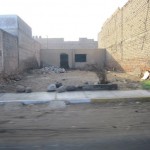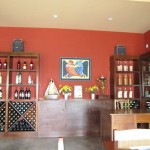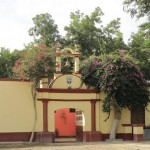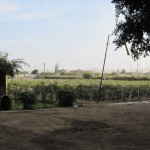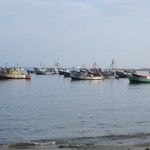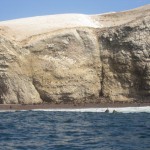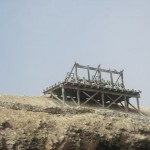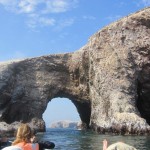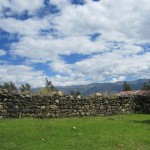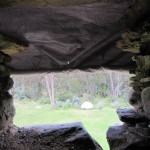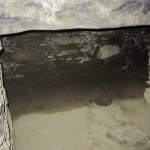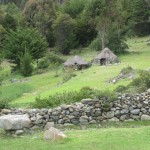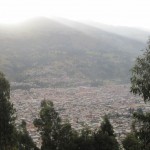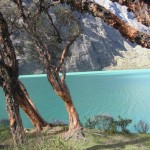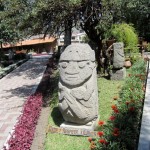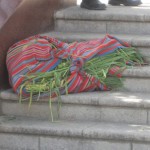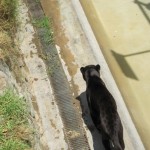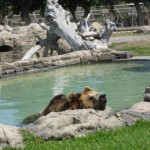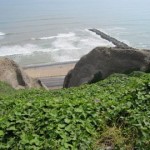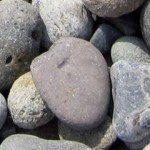May
12
Let’s talk for a few minutes about the place that is, after all, the reason that I’m in Santiago. Looking back, I guess I expected that it would be mostly like US campuses I’ve visited, minus the extravagant building projects, but I didn’t give the question much thought. Given that lazy preconception, I was really surprised: the school and the students are qualitatively different from their US counterparts in several ways. USACH reminds me, in almost every aspect, of what I imagine (both from movies and from the fact that in the course of my fifteen years of education alone thus far I’ve watched dramatic changes in the level of technology available in the classroom) universities in the US must have been like twenty or thirty years ago. And I mean than in the most complimentary way possible. In fact, it really is a compliment.
Most of the classrooms (certainly in the Facultad de Humanidades, or FAHU; lack of funding for the humanities seems to be a universal problem) are un-air conditioned and un-heated. Some of them are not even fully enclosed. None of them (again, in the FAHU) have installed DLP projectors or computers or video screens or even overheads. No fancy lighting, no padded desk chairs, just the class and the teacher and the white board.
The campus is too open to be described as labyrinthine, but it is huge and certainly difficult to find your way around. None of the buildings with classrooms have names or are otherwise labeled, and there’s no rhyme or reason so far as I’ve seen to the numbering of classrooms. Damned if I can find anything without asking for help.
That being said, I also think it’s beautiful. As a result of being so spread out, there are courtyards and trees and grass everywhere; as a result of the lack of indoor seating (as well as, I’m convinced, the lack of wifi), there are groups of students at all hours of the day laying out in the grass, reading on benches, eating together in the courtyards, and the concentration of students into general areas by Facultad means that you start seeing familiar faces quickly. Even though I’m not necessarily a part of it yet, there’s a strong sense of community and belonging on campus. And did I mention it’s beautiful? The way the light hits north campus in the late afternoon, the sun filtering through the trees at noon, and on clear days, you can look up and see the cordillera of the Andes in the distance.
The students also seem different, in some ways. There are, for instance, a lot more awkward engineering types, with their long hair and punk band shirts looking straight out of the ‘80s. But that’s neither here nor there; more important is that the students are extremely welcoming, and always excited to talk to and help out the exchange students (much appreciated!).
A bit of history: USACH is the former Universidad Técnica del Estado (which in turn was the former Escuela de Artes y Oficios, founded 1849). As the name suggests, it was a state-run technical university established in 1947 principally for middle- and lower-income students to become engineers and assist in the national development project of import-substitution industrialisation. It became the Universidad de Santiago de Chile in 1981. The university retains its middle-to-lower class sensibilities to this day, which something that most students and professors take a lot of pride in; they will claim that where the upper-class U Cátolica and U de Chile population spends its time pretending to be European and denying the existence of the masses beneath them, USACH reflects the “real Chile” (in terms of culture and demographics) and provides opportunities to any number of lower-class and first-generation college students every year.
The former UT has a rich institutional culture (“Somos, somos los cachorros de la U, de la U-ni-ver-si-dad (Técnica!)” is the interminable soundtrack to the first few weeks of classes as the freshmen are marched through campus as a part of the initiation into their chosen majors) and a tradition of political involvement continuing to this day, which has left its mark on the university in multiple ways. Every Friday, without fail, there are multiple carretes (parties) inside the university grounds, which start around four o’clock and go ‘til the drinks run out; then, every Monday, I walk into my early-morning ayudantia and note the new political graffiti on the walls outside the classrooms. There are also bigger, more permanent murals, and no less than five leftist student organizations (all of which were out in the Escuela de Artes y Oficios recruiting heavily at the beginning of the semester). And the university campus is completely fenced in: the Matucana entrance is closed on Fridays (presumably to control access to the carretes), and there are guards not just at the entrances but also in the gardens! And by gardens I mean landscaping, which is most large patches of grass. But they don’t seem to do much, from what I’ve seen.
More to the point, at least once every two weeks or so, students are sent running for classrooms to wait inside as demonstrating students get into altercations with the Carabineros, resulting in arrests and the launching of tear gas. I’m not really sure why the tear gas is necessary (or allowed on campus! It’s clearly a health and safety hazard to all the other students who are just trying to go to class), or why the Carabineros seem to get called every time, but I’m equally unsure about the potential usefulness of some of these demonstrations. (Does it really make sense to protest rising metro prices inside the university and then get arrested/tear gassed by police there when clearly the more logical thing to do would be to protest directly at the Transantiago offices to people who could actually change the situation, for instance?)
Today is a little bit different. I’m sitting in my room right now writing this because classes in the FAHU have been canceled due to massive student protests (manifestaciones) near Metro Baquedano. They’re protesting the recent hikes in metro fares and the price of student passes, the lack of scholarships and financial assistance for students affected by the terremoto, and the lack of representation in the national higher education decision-making process.
I’m just glad to see that students have organized a peaceful protest that will hopefully be more effective than on-campus protests, which are mostly just disruptive and inconvenient without any positive results. The disruption and inconvenience of shutting down the Plaza Italia for a few hours (in conjunction with coordinated protests across the country) and making national news for it, though — that I can support as an example of effective activism. So, more power to them! I can’t participate in protests on pain of deportation, but it’s really refreshing to see this kind of involvement and personal investment of students in the state of their higher education in Chile.
Anyhow, that’s enough editorializing from me. I do still have lots of reading to do — off to work!
May
11
— “So, what do you think of Chile?”
“Well, I like it a lot, you know? I haven’t gotten to travel enough yet, but I really like Santiago.”
I haven’t figured out how to give a more complete answer than that yet, but I’m working on it. Fortunately, this seems to suffice.
— “What do you study?”
“In the US, I study estudios internacionales, and here I’m finishing minors in Spanish and Latin American Studies.”
I generally get looks of confusion about some part of this answer, whether the question is “What in International Studies?” or “What’s a minor?” or “How can you study so many things at once?” (When you enter university in Chile, you pick one carrera and stick with a very strict course schedule for five years.) or “Oh. Latin American Studies.”
The last “question” is something I have a lot of trouble responding to, which leads me to:
— How many continents are there?
“Seven. Obviously.” Except apparently it’s not so obvious.
Ask a South American, and he or she will say, “No, it has to be one (America) or three (North, Central, and South) continents.” To which I reply, “Look at a map! The area we give the (completely appropriate) political designation “Central” to clearly belongs to the North American continent, geographically speaking; how can you possibly distinguish between Europe and Asia (as most of them do) and refuse to recognise that North and South America are geographically separate?” This line of reasoning, however, goes nowhere, and just goes to show how differently even the “facts” we learn in the second grade can be viewed, sometimes. (Poor Pluto’s fate is another good example!)
More to the point, though, I have so much difficulty with adjectives here. I’m never an “americana” but an “estadounidense” (a word that, tellingly, doesn’t exist in English, lit. “United States-ian”) — okay, that’s fair, we’re all Americans after all, and I frankly don’t like self-identifying as an American either in any language. But when to say “latinoamericano”? Is “sudamericano” (South American) ever okay? And what does it mean? Am I using it pejoratively? Why should it be perceived as pejorative? As far as I can tell, it’s just descriptive. And why should I feel bad or silently judged for having a minor in Latin American Studies? In other words, what would you rather we call it? Particularly due to the lack of an “estadounidense” equivalent in English, simply “American Studies” means something entirely different to us. I just hate feeling guilty and defensive (rightly or not) when explaining the estadounidense perspective on issues like this.
I joked to a friend in the States that I should just give up the semantics game and start identifying simply as a Texan — confirming all her worst suspicions (as a Missourian) about our pride and exceptionalism :P.
— “What’s your last name (apellido)? Y, segundo apellido?”
(In most Latin American countries (and Spain/Portugal), the first apellido is the father’s name, and the second is the mother’s — and women don’t give up their name at marriage. So, most people go by their first last name (abbreviating, for example, María Márquez M.), though it’s up to each individual which name(s) he or she wants to use.)
“Well, I don’t actually have a second last name.”
As my lit professor opined today, “It’s interesting, isn’t it, that in countries where women have so many rights and opportunities (which includes more than just English-speaking countries, it should be noted), they still give up their last names at marriage?” (Immediate response from one student: “What? But that was just in the past, right? Aren’t things are different now?”)
So, extrapolate from this what you will about the differing roles and importance of tradition and lineage and religion in these different areas of the world (or better yet, do some research, like I ought to do); it’s an interesting thought exercise.
— “Spanish is a difficult language to learn, isn’t it?”
Funny, that’s what I tend to assume about English. Spanish certainly has its pitfalls, including conjugations, agreement, and tenses galore, but all things considered, it was (is) nothing next to my current task at OU of learning Russian. And while this has a lot to do with the fact that Spanish has a lot more in common with English than Russian, I’m also positive that it’s directly related to the fact that I started learning Spanish at age twelve. Every time I remember a vocab word from the eighth grade (I pulled the word for stapler (“grapadora“) out of the air the other day, much to my surprise), or use a verb in the subjunctive without a second thought, I become more convinced of this.
— “So, America. Guns, right?” (followed by shoot-’em-up hand motions)
Yep, that’s how the conversation started. The ensuing encounter was a good example of me failing to handle myself with grace and civility and give the questioner the benefit of the doubt. The acquaintance in question is from Europe, which I failed to immediately process but gives the question a little more context, but I was mostly completely taken aback by his tone and abruptness (for goodness’ sake, we were being introduced at a party!).
So I gave an equally abrupt, annoyed, semi-coherent answer in which I explained the Second Amendment and concealed handgun laws as rationales for and examples of the rhetoric and culture surrounding guns in the US, and tried to paint the issue as not necessarily partisan (okay, that’s a bit of a stretch). I’ve given the question a lot of thought myself, and have emerged unequivocally ambivalent about it, which more than anything accounts for my combative tone and obvious irritation in answering his question. (Actually, upon re-reading, that’s ridiculous. What got under my skin was clearly the unabashed stereotyping (especially after he learned I’m from Texas) and his offensive presentation of it.) At any rate, it’s stuck with me as an example of how not to respond on behalf of myself and my country.
— “What do you think of Obama?”
“Well, I voted for him.” This is usually all the questioner wants to establish; most of them don’t actually follow American domestic politics, from what I can tell (hard to blame them, it can get pretty depressing sometimes).
(“Oh, Texas. That’s where George Bush is from, right?” generally carries the same subtext.)
Going to build houses in Region XI (still not sure exactly where) tomorrow! Wish me luck!
May
10
Here’s something I hate about city life: street harassment. In fact, hate is really not a strong enough word to describe my feelings about getting whistled at or called out to or honked at repeatedly or just stared at on the street daily (I especially detest encountering a line of cars at a stoplight, every driver pointedly staring at me as I walk past*), not to mention being persistently hassled and propositioned as I walk through the ferias (markets) by men of all ages, and I want to shout at every one of them to show some respect and leave me alone (or another two words OU would probably rather not see here).
*I spent a bit of time just now looking for synonyms for ‘stare,’ both because I used it in two successive phrases (for shame!) and because it’s not quite correct, but can’t find one. It’s hard to adequately describe what exactly these men who watch me from their cars (in particular) are doing: it’s not gaping, or eyeing, ogling, gawking, peering, or even “checking out” — it’s this strangely almost blank gaze, completely unapologetic, as if I’m not an actual person walking past on her way to school, but some mirage there for their momentary viewing pleasure. But at the same time, their stares are so concentrated, so intentional, and so entitled that it’s hard to say that they’re not cognizant of the fact that I must be feeling something (hint: it’s objectification and vulnerability with a healthy side of rage) about this unsolicited and unwanted attention.
All that said, it’s really important to point out that I have (almost) never felt physically threatened here, especially during the daylight on my usual route to school, and so on. And I know that street harassment is generally a problem in cities everywhere.
Also, harassment of the complimentary variety generally doesn’t bother me, but makes me smile (albeit in embarassment), like the guy on the street who called out to offer the galletas he was eating to my friend and me as we walked past, or even the men who walk over to me in the grocery store to whisper, “Qué hermosa eres” (and nothing else). Which is, I guess, to say that the ones who make the effort to verbalize their thoughts about my presence in a positive, non-threatening, almost respectful way.
As a direct result, headphones have become my first line of defense against a lot of this harassment, especially when I’m out on my own walking along Matucana to and from the university or shopping, and it bothers me a lot. I don’t want to disconnect from what’s going on on the street and duck my head and hurry away from anyone who looks at me — but the only people I look at, much less make eye contact with anymore on the street are women and little kids. And I will never get used to it, never just chalk it up to “culture,” and never be okay with it. So you tell me, who’s right here?
—
I was talking to a friend at home about the above entry earlier, and told her that I couldn’t post it until I came up with something positive to balance it out. So here goes:
I spent a good portion of last week agonizing over worries that I’m not where I want to be (in almost every respect) and not fully maximizing the opportunities at hand: Where should I go on feriado in a few weeks? (And why did I waste so much time before school started?) Should I have taken different courses this semester? Why am I not already more involved on campus? Should I move out of my residencia to a house where I can cook in peace? Wouldn’t I really rather be in Buenos Aires? but I’ve finally snapped out of all that a bit.
My neighborhood is beautiful. It’s easy to miss (or mistake); Barrio Yungay is in one of the poorer areas of the city, full of terremoto-damaged and abandoned houses, graffiti, litter, and a general grunginess that you’d never see east of (“más arriba de“) the Baquedano metro station. But these old houses have charm and dignity, too, the streets are lively (especially on market days) and the way the light hits the houses and the trees in fall colors at almost any hour of the day is just gorgeous. Walking to and from school, taking side streets to avoid the noise and harassment (and for a better view!), is one of my favorite parts of my day.
I went to a Banda Conmoción concert Saturday night on a whim — I asked everyone else going, “Qué tipo de música es?” and no one could give me a good answer, or even an answer at all. Instead, I got lots of futile hand motions, and, “Well, you know, it’s a mix of, it’s just really good! Come with us!” and I’m so glad I did. I couldn’t tell you what kind of music it is either, except that it involves about twenty performers, including several trumpets, saxes, clarinets, drums, trombones and a sousaphone (as well as a dancer and a man who leapt around the stage in a demon costume), seems to borrow some from Chilean folkloric music (cumbia?), has super-catchy lyrics, and can keep a crowd of several hundred dancing (and jumping and occasionally crashing into each other) until five in the morning. In other words, it was great fun, and was really a step outside the norm for me.
One thing I learned quickly upon arrival is that probably the biggest part of any travel experience is the people you meet along the way, and I’ve had the privilege already of meeting some great friends from all over the world. I don’t want to wax poetic for too long here, except to say that I’ve found some of the most welcoming, generous, kind people here (at my residence and the university) that I’ve ever met, and it’s really made my experience so far.
When I arrive back at the Quinta Normal metro station, whether from a weekend trip out of the city or even just a long day across town, I’ve started to think, “Home again at last.” And that’s about as much as I can ask for for these few months, really.
In other news, I’m going (I’m almost positive) to the south this week to help build houses with USACH! Updates to come!
May
9
We didn’t end up going to Cajamarca this weekend after all. On Thursday, we purchased our tickets at Cruz del Sur (ida y vuelta), and boarded the bus. However, after only twenty minutes or so, I vomited (sorry) all over, multiple times. I’ll leave the details at that :/ I have no idea why I got sick. Maybe it was motion sickness? Although that doesn’t normally happen to me…. Anyways, we got off the bus in Los Olivos and took a taxi back to Cruz del Sur durante “la hora punta” according to our taxi driver. There is a lot of traffic around 6 o’clock. We payed him and tipped well (because I also puked on his taxi :/ and then he was gracious enough to pull over for me). I didn’t get sick for the rest of the night and only had a headache for the next day or so. I cannot explain this bout of sickness, but we’re chalking it up to a sign that this was not the right weekend to go to Cajamarca :/
We took this opportunity to relax in Lima, which was nice since we just finished midterms.
On Friday, I rested most of the day. For dinner, we checked off El Carcochito from our list of restaurants we want to try! It was great we both had orange juice and chicken tacos with mucho guacamole riquísimo!!
On Saturday, Calin and I went to el teatro en Miraflores se llama ICPNA and watched “El Noche Arabe.”. It was quite the experience 🙂 We were prepared for the 1001 Nights, Arabian Night story. Instead we got a crazed woman who was nude or wearing transparent clothing throughout the entire play who somehow traps one man in a bottle, another in the desert, and another in a weird room. Each man encountered the crazy woman in her apartment sleeping, and after interacting with her the men find themselves in thier different scenarios (bottle, desert, weird room). The third man was the boyfriend of her roommate, and upon upon finding the two together, the roommate becomes enraged and a bit psychotic. At the end, the man from the desert (who was also the maintenance man at the apartment) and the delusional woman fall in love, the roomate kills her ex-boyfriend, and the man in the bottle dies when the bottle is dropped from the apartment. Confused? Yeah, so were we. haha. The only thing similar to Arabian Night was the cheating, the desert, and that the roomate’s name was Fatima. If anyone can explain this rendition, please feel free to do so!! But we’re glad we went and experienced this unique performance despite the craziness.
Today, Mother’s Day, Calin and I called our moms, worked out, and then went to a family get-together. We accompanied our host parents to Enrique’s brother’s house. (Enrique is our host dad). Here, we met much of Enrique’s extended family. I really, really enjoyed this experience and am so glad they invited us along! I loved chatting with everyone, eating chifa and chocolate cake, and being part of a Peruvian family gathering. I hope that we do it again for Father’s Day!
I can hardly believe that my 9th week has come to an end. Tomorrow marks the beginning of our 10th. I feel that I’ve accomplished and experienced so much already, but at the same time I feel that I have SOOO much more to do! My Spanish is not near as good as I would like it to be. As much as people might compliment it, I still struggle to understand every word of a conversation or say exactly what I want. My Spanish has improved since my arrival; I am more comfortable when speaking and can always converse, just not always quite as articulately as I’d like. I would love to improve a lot more before leaving! I definitely agree with Helen (Chile Blog) in that the language barrier is one of the more frustrating things about studying abroad! All the other differences are exactly as she said–things that we set out to experience. If life in Peru were just like that in the US…it wouldn’t really be an exciting, learning experience–just merely an extension of my everyday life.
All this said, I am so excited to start my 10th week! I’m looking forward to my classes, receiving my midterm grades, our first trip to Lima’s Plaza de Armas, and whatever our next weekend’s activities may be!
May
6
This past week I finished my first (and last) round of Peruvian midterms! I have been in Lima for 9 weeks now and have 9 more left! It has gone by sooo quickly!
Midterms were stressful, but I’m happy to say that I survived and had worried more than necessary (as is usual for me and test blocks). In about 10 minutes Calin and I are going to leave for our third side-trip of the semester. We’re going to Cajamarca!!! Calin is especially looking forward to this trip because she knows so much about the history behind the city!
Our previous two trips were to the Pisco/Paracas/Ica area (all three are cities in the Ica region of Perua) and to Huaraz. Both trips were successes!!
Trip 1: Pisco/Paracas/Ica
The Islas Ballestas and the Reserva Nacional in Paracas were beautiful. We loved seeing the animals, the candelabra, and the juxtaposition of sand and sea. The bodega in Ica, Vista Alegre, was also really cool! We took a tour of the vineyard and saw how wine and pisco are made, and then we taste tested! My travel guide (lonely planet Peru) was a little misleading because it was written pre-2007 earthquake. The earthquake hit the area hard, and the cities had done little to reconstruct. So we had less things to do than expected and cut our trip short– 2 days. We stayed the night in Pisco at a hostel, which I would recommend, named Villa San Manuelita! I think if I were going to do this again, I would do Huacachina (sandboarding,etc), Ica, Pisco, and Paracas all in a 4 day trip. Pisco is about 3-4 hours from Lima, and Huachachina and Ica are pretty close together and only a couple hours from Pisco. We took Soyuz. They have bus departures every 20 minutes to all parts of the South.
Ok–I’m leaving for Cajamarca now so I will finish this blog soon and add pictures!!
——————————————————————————————
Trip 2: Huaraz
Huaraz was indescribably beautiful. The mountain views and lakes were breathtaking. We also got to see many campesinos/as in traditional dress, llamas, alpacas, and other farm animals. Huaraz is a 7-8 hour bus ride from Lima. We took Movil Tours overnight and purchased semi-cama seats.
Upon arriving to Huaraz, we called Carolina Lodging, a hostal highly recommended by my Lonely Planet. We, however, did not have very much luck with them. They wanted to keep our passports (which we didn’t bring because it’s unsafe to do so–We had copies), and since we didn’t have them they wanted a 100 sol deposit. 100 soles was more than 3 nights worth of payment. They also refused to give us a receipt for this deposit.. After much arguing (I was being polite, but there was a definite miscommunication and not linguistic), we ended up leaving the hostel.
We called another hostel, Alojamiento Soledad, and an employee came in a taxi and picked us up from Carolina Lodging. She was very accomodating, and after interacting with her, we knew we had made the right decision. The hostal was beautiful and economical to boot. It had a terrace with mountain views, a patio, a dining room,a communal living area with tv and couches, and brightly colored bedrooms (ours was yellow). Breakfast of té and pan con marmelada was also included!
After breakfasting, the empleada helped us find a combi to Willkahuain (we tried and failed to do so by ourselves :/) The combi was a bumpy and squished experience. We started from Huaraz and traveled up a gravel trail into the mountains, picking up more and more people along the way until we could not possibly fit any more. As uncomfortable as it was, I kind of enjoyed it. (Also–side note: the cobradors in Huaraz do not call out their destinations like in Lima. As a result, it is very difficult to decide which one to flag down.) In Willkahuain, are ruinas de la cultura Huari. We took a tour of these ruins with the help of a local guide who spoke Spanish, Quechua, and some English. (We took the tour in Spanish.) Our guide was really great, and he said he worked as a volunteer and not for pay….but really this means he works for tip 🙂 Later that night, our hostel arranged a taxi to pick us up and take us to the Mirador, a beautiful location with panoramic views of the city of Huaraz and a huge turquoise cross, covered in graffiti. After the Mirador, Calin and I shared a dinner de Brucheta (sp?– they were like shish kabobs) at El Encuentro, una restuarante bien bonita en Huaraz cerca de la Plaza del Armas. After dinner, we met up with some Oklahoma friends in la plaza and went to El Tambo., a pub with great live music.
The next day, Saturday, we left at 6:30 am for our trek into the Cordilleras Blancas. Our guide, a sister of the empleada at the hostel, met us at the hostel to take our taxi. We took a 3 hour taxi drive up to Laguna Llanganuco, trekked up 3 hours to Laguna 69, trekked down for 3 hours, and then took the taxi back down for 3 hours. This made for a long, very dangerous, but beautiful day. The taxi was not not not safe and the trek was soooooooooo hard (altitude and upward climb), but the views were absolutely spectacular. I’m glad we made it back safely! And I can say with confidence that the trek was one of my best and simultaneously worst experiences ever!!! Again, I cannot stress enough how BEAUTIFUL everything was (see pictures below). En fin, una aventura buenísima.
On Sunday, we woke up early and walked to the California Cafe for breakfast. This cafe is owned by a man from California–he hosts ultimate frisbee tournaments every Friday. This was cafe was so cool and the food was DELICIOUS! We had panqueques rellena con manjar blanca y fruta, huevos revueltas, pan con marmelada, yogurt, papas con cebollas, té, y un banana milkshake. This was a special (one plate!!) that Calin and I split. After breakfast, we went to the Museum of Anthropology, meandered around the plaza, took pictures with alpacas, went to an Incan market, and then went back to our hostel to catch a taxi to the bus station.
Our trip was awesome! But everytime we travel away from Lima, we are so relieved to be back again. I guess it is kinda becoming like “home.”
Pictures are all mixed together. In order they are of pisco, bodega, islas ballestas, our hostel in Huaraz, willkahuain, mirador, trek, museum, plaza de armas, …. if you click on them, you can see a larger view and also headings with the location.
- This is how most of Pisco looked
- This is where we tasted their wine and pisco.
- Front of Bodega where we started our tour
- Bottling machine
- Vineyard
- Candelabra.
- Harbor in Paracas
- Humboldt Penguins
- This is where the beach where all the mother seals and their babies hang out. The little seals also learn to swim here!
- This is a contraption that collects guano.
- room at Alojamiento Soledad
- One of the views from the terrace at our hostel
- Outside the las ruinas de Willkahuaina
- Torch holders–Ruinas Willkahuain
- Inside las ruinas de Willkahuain
- Lookout of las ruinas de Willkahuain
- Altar for animals sacrifices. Ruinas de Willkahuain
- Huts outside ruinas de Willkahuain
- Mirador
- View of the city of mirador
- View from Mirador
- View from Laguna Llanganuco. Cordilleras Negras entre Cordilleras Blancas
- Laguna Llanganuco
- Final Destination of Trek: Laguna 69
- Cow crossing during our trek
- View of Mountains during trek.
- display of Prehispanic tomb in the Anthropology Museum
- LIthic art in the Lithic Art Garden in the Anthropology Museum
- Plaza de Armas–alpacas
- Plaza de Armas–us with the alpacas!
- Plaza de Armas–Alpaca food
- Roasted pig!
May
3
Reading through Bobbi’s recent posts got me thinking about what exactly those words mean for me; to tell the truth, I’m still not sure. It’s probably easier to start here by talking about homesickness, which is something I get asked about a lot.
Honestly, I really don’t feel homesick. I don’t spend my time wondering what’s going on in the US and wishing I were there (and anyhow, friends and family are only a facebook chat or skype call away these days). My take on the issue is, I have a plane ticket booked for July. I’m going home then without question, and truly I’m more worried about not having the time to fully enjoy my time in South America than about what’s going on there. Though I can’t define it very well, homesick is not what I feel.
Culture shock, however, strikes me as a much more nebulous question. It’s another thing I get asked about a lot,* and I generally have a lot of trouble answering. There are a number of ways to approach the issue. For one, most extranjeros I know are equally struck by the fact that people and personalities are a lot more individually variable, and a lot more constant across cultures and nationalities, than any overriding “national” characteristics.
*and unfortunately, the question usually comes couched in unflattering, self-deprecating terms: “So, what are your impressions of Chile/South America/el tercer mundo? Underdeveloped?” (The Spanish term is subdesarrollado, which somehow strikes me as much more pejorative than the English.) This is a pretty uncomfortable discussion to get into, as is trying to explain that we don’t use terms like Third World anymore: “less developed countries” and the even more recent “Global South” are the post-Cold War euphemisms of choice — which in any event doesn’t change the political and economic reality we’re talking about.
On the other hand, I could run through a litany of little differences and quirks of life I’ve run into here, like the fact that all the food that comes in jars or bottles or cans in the US (e.g. jams and jellies, mayonnaise and all other condiments, olives, spices, sauces (especially tomato), hot sauce, salt, cheap hand soap and shampoos, etc) comes in little plastic bags here, which tends to be inconvenient, messy, space-saving and far less wasteful.
– Or the fact that there are no trash cans on the streets in my neighborhood.
– Or that students aren’t allowed into the stacks of the university’s libraries, but have to ask at the desk for the specific books they need.
– Or that on nutrition labels, listing sugar content doesn’t seem to be mandatory, but artificial sweeteners must be listed in bold print with an accompanying table showing sweetener content per portion alongside the RDA per kilo of body weight (an interesting reversal of national preoccupations?).
– Or that everyone smokes, even indoors.
– Or that all football (i.e. soccer) matches require careful pat-down and bag searches to enter the stadium, heavy police presence (complete with bulletproof shields!), and razor wire and electrified fences between the fans of opposing teams. All that said, football games are really fun; there’s a lot of active participation, the singing and chanting of the fans never stops, and the players are very theatrical on the field. For lack of a better word, it’s almost like a… game for them.
– Or that public restrooms are hard to find, often require payment and don’t necessarily promise toilet paper, toilet seats, or hand soap.
– Or that USACH only has a few wi-fi hotspots so far — which means that students spend a lot less time on their computers and more time talking to each other.
– Or that produce and bread are sold by the kilo (well, go figure) so what looks comparable to US prices is actually much cheaper, a pleasant surprise.
– Or that almost nobody places their phones on silent/vibrate. My tentative theory is that an audibly ringing phone makes the necessity for the person to extract him- or herself from a conversation clear and immediate to both parties, and thus more excusable. Which is more polite, in a counter-intuitive sort of way.
– Or that the Chileans I’ve run into who speak English have tended to speak British English, which seems noteworthy to me only because of my lazy preconceptions about the ubiquity of American English, I know.
I could go on, but these are, like I said, little things. I didn’t stop short, close my eyes and start whispering “There’s no place like home” upon encountering any of them, or even the sum of them. There are only a few things on that list that really bother me, and overall (and this is maybe the most salient point of the discussion when talking to Latin Americans) my standard of living in this country is just not markedly different from home. But the point is that I didn’t come here expecting just another American city (though the richer neighborhoods of Santiago can definitely feel that way) — I came here to experience these differences.
So what is culture shock, then? Maybe I can answer this way: the only thing that I’ve had real, significant trouble adjusting to here is my lack of Spanish comprehension, both in class and in conversation. I wrote the following up a few weeks ago, and though things have been rapidly improving since then (my reading comprehension in particular is getting exponentially better), this still describes my day-to-day experience, more or less:
Instead of hearing and instantly understanding (in terms of deciphering the accent and knowing what the words mean) and being able to hold several paragraphs of a professor’s lecture or even just a text in my head at once, being able to assimilate it into whatever pre-existing knowledge I had about the subject and think about possible ramifications of/applications of/problems with or counter-arguments to/further questions about/possible biases in/extensions of the information presented and being able to formulate a clear and coherent response to it in less than thirty seconds or so, I’m struggling with just the first two; even holding contiguous paragraphs of a lecture in my mind to give context to whatever stream of words is coming at me next is a challenge sometimes.
I hate it. It’s so difficult just to pay attention; there’s no such thing as passive listening for me in Spanish yet, because if I sit back and try to just absorb and understand a few paragraphs before writing it down, I usually end up with vague impressions, fleeting images or “feelings” about what I just heard, and few if any concrete, repeatable (or write down-able) and explainable facts, and then suddenly I’m missing what he says next. It’s almost like the process of remembering a dream. Probably the most difficult thing to do is to write something down while simultaneously listening to whatever is coming next (though it’s easier to write in English and listen in Spanish sometimes, presumably because I’m legitimately comprehending the content of at least one activity).
And so I’m stuck in class, taking copious notes, trying to cope with questions suddenly thrown at me, both in terms of understanding what the professor is asking me and then forming a coherent, Spanish-language response within an acceptable amount of time, and all of the real understanding comes from going back, recopying notes and starting to make sense of the words I’d earlier taken down like a dictation machine.
I don’t know whether this counts as “culture” shock per se, but it has definitely characterised my experience in Chile so far. More than anything, it’s shown me how easy it is to take something as simple as a conversation for granted. Point being, I think that being here is teaching me, if nothing else, a lot about empathy.
Apr
27
Hi everyone; I’m getting into this blogging game a little late, so let’s get right to the story so far: I’m a second-year Russian and East European Studies major at OU, currently studying at the Universidad de Santiago de Chile (or USACH) in order to finish Latin American Studies and Spanish minors.
I arrived in Santiago on March 11 (about two weeks after the earthquake), and quickly moved into El Punto, a residencia universitaria for international students. It’s essentially a big dorm with a shared kitchen, living room, and patio (though I have my own room — with a balcony!). I live with about sixty other exchange students from all over South America and Europe, principally from Brazil and Spain, and I love it.
As the only OU student in Santiago, I was extremely lucky to stumble upon such a great community of other international students to live with. I got luckier than I knew, actually, because about half of the people at El Punto are also students at USACH. This was (and is) incredibly helpful because one of the first things I discovered was that the Spanish I remember from high school is not nearly sufficient (yet, I hope) for me to be self-sufficient here. Combine that with the fact that living with other people is always more fun, and that these particular people are unbelievably welcoming and caring and helpful and have seemingly unlimited patience with my somewhat limited Spanish, and I couldn’t be happier.
After arriving all in a rush (I had to delay my flight out for a few days), I soon learned that the start of the semester had been pushed back until March 29 to accommodate students affected by the terremoto. What did I do with my two suddenly free weeks? Regrettably little. I’ve realized since then that I should have seized the opportunity to travel a bit before school started, and also before it got cold! I knew the seasons were flipped here, but I didn’t realize that it would get so chilly so fast! (“Just wait ‘til June and July,” my Chilean friends tell me. “Then it rains every day, too.”) The climate changed almost overnight, and it’s not going back — I’m no meteorologist, so don’t quote me on this, but something about being only thirty miles from the ocean (rather than hundreds, like in Oklahoma) makes the climate much less variable. On the one hand, it’s easier to plan according to the weather, but on the other there’s just no relief! Just lots of big blankets and gatherings in the living room. But I digress.
Anyhow, those two additional weeks free did give me time to explore the city with my new friends, visiting various museums (this city is full of museums), parks, markets, and one of Pablo Neruda’s three houses; we also went to Viña del Mar (where OU has another exchange program with the Universidad de Viña del Mar) and Valparaíso for a weekend. Viña is a resort town with beautiful beaches, and Valpo is a port town with beautiful houses and street art. Those two cities are just a two-hour bus ride away from Santiago; since we didn’t spend nearly enough time in Valparaíso, we’re planning a day trip back sometime soon.
This extended vacation of summer weather and no obligations past getting to know my housemates and the city had to come to an end though; I’ve been in classes for about three weeks now, taking Pre-Columbian Cultures, Latin American Literature II, History of Chile in the 20th Century, and The US and Central America (as well as Pilates and Ceramics, since all of the art and sports classes here are free and open to everyone!). Just functioning in Spanish can be difficult sometimes, not to mention learning in Spanish, but I’d like to think I’m up to the challenge. My first test is next week — I guess I’ll find out!
Apr
13
Since I last posted, I have been enjoying all that Lima has to offer– post-culture shock 🙂
On the Friday before Easter Calin (friend and roomate, also from OU) went to a “country club” near our house. Our host dad showed us where to go and how to get in. We spent the day sunbathing, drinking, eating, and just enjoying each other´s company. I had an awful sunburn as a result of the sun only shining on my left arm–lessoned learned there. On Saturday, Calin and I went with Karla and her mom to Pulpos–a beachtown about 1 1/2 hours from Lima by bus. We loved the beach and the seafood! On Easter Sunday, Calin and I went to El Parque de Leyendas with the chica that works in our house, Marleni. This park is a zoo! It has exhibits showcasing the animals of the different climates/terrain of Peru–the jungle, mountains, and coast! It was really cool and 10 soles well spent. On Easter night, Calin and I went with our host mom to mass. It was a little weird attending a service so different to what I’m used to, but I still enjoyed it and the church was beautiful!
- Abuelito Mono–This is a cute little grandpa monkey!
- Easter Bird–Since I was missing out on Easter US-style, I elected this little guy to be my special Easter bird.
- Elephant Ears–These reminded me of home and my mom <3
- Love Birds–This is Jon and I 🙂 I’m the red one.
- Cool jaguar! Black spots on black fur!
- Mariposa–I love butterflies! and am so thankful for the Parque de Leyendas gardeners for brightening my day!
- Tired Oso
I have also recently discovered one of my favorite restaurants in Peru!!!!!!!!!! —La 5ta Estación, which is a restaurant only a few blocks from my house. This restaurant is diner style– seating is at a bar where you can see them cook the food and is open to the fresh air (no doors to the outside)–and they also serve like a drive-in when cars pull up! They serve sandwiches, platos tipicos de Peru, and the best fresh juice ever!! I´m obsessed specifically with their orange juice for two reasons: 1) it´s absolutely delicious and freshly squeezed 2) you can´t find real OJ in grocery stores here–only mandarina. I also love to mix their strawberry and orange juices together 🙂 There is another restuarant named the Las 4 Estaciones. They appear to be of the same chain–same colors and everything, but according to our host dad, they have a different owner and the Las 4 is the original and better. Guess I´ll have to try it out too 🙂
Here is a running list of my favorite Peruvian foods/restaurants:
Causa–lemony, mashed potatos with chicken salad inside–served casserole style
Chifa–one dish in particular I like, but don´t know the name: it has pineapples and chicken served over rice with a sweet sauce
Lomo Saltado–like fajitas with more juice served over french fries and rice
Ahi de Gallina— ahi and chicken mixture with a creamy sauce served over boiled potatoes
Guiso–kinda like stew with a little less juice and of course, served over rice
Jalea Mixto–basically a big plate of different kinds of seafood all fried–shrimp, calamari, octopus, white fish, clams, etc. We tried this dish in a small restaurant in Pulpos. (I also tried Leche de Tigre while in Pulpos–lemon, cilantro,choclo, onions, and raw/”cooked” fish like in ceviche, and a lot of liquid. This was a good experience, but I don´t think it´s something I´ll want to order again :))
Chifles— fried platanos–kinda potatoe chip-py. You can buy them at street vendors or at many restaurants!
Mangos–Restaurant in Miraflores inside a mall called Larcomar. Really nice atmosphere and good food with a great view of the sea if you get the right seat 🙂
La 5ta Estación–description above 🙂
My List of foods/restaurants to try:
Roky´s–Pollo a al brasa
Mi Carcochito–Mexican food
La Rosa Nautica–restaurant in Miraflores which is situated on top of a “peninsula” (for lack of a better word) of rocks
anticucho–cow´s heart
ceviche–citrus marinated fish, which appears raw but is technically “cooked” by the citric acid
School has been getting better/easier every day as I´m becoming more comfortable with my Spanish and my schedule here in general. Calin and I also joined a gym here this past week! It´s really near our house and offers good equipment as well as various group classes! We went to pilates yesterday!
We have yet to take a “side-trip” outside of Lima, with the exception of our afternoon at Pulpos. We are hoping to go to the Paracas/Pisco/Huachachina area this weekend! Wish us luck with travel arrangements!
Mar
31
Sharing this is a little embarrassing, but I do it for a few reasons:
1) To let future study-abroaders know that they are not alone in feeling frustrated/discouraged while experiencing culture shock.
2) That culture shock does happen and can be severe–certain destinations are not for the faint hearted–choose wisely.
3) To cope with my feelings and say GOODBYE to them! 🙂
I am admitting that I have now experienced TRUE culture shock on what is my 3rd study abroad trip. I have had many ups and downs these first 3 1/2 weeks. I was often discouraged by my classes, people, transportation, boredom etc. At one point, I truly considered coming back home.
However, things are now back in perspective for me. I came to Lima to accomplish certain goals of mine:
–Experience a new culture for a longer period of time than I ever had before (my other two study abroad were one month apiece)
–Become more fluent in Spanish
–Take Quechua lessons
–Challenge myself and grow my levels of confidence, independence, and travel skills
These goals are definitely works in progress, but I have already gained some unexpected lessons from my first 3 1/2 weeks. It never hurts to get old ideas reaffirmed in new, memorable ways 🙂
–Things are not always as expected. You have a choice to give up or get tough.
–Lima can be liberating. Studying abroad can liberate you from outside pressures that you never realized existed. For example, in the future I might want to settle down in a place that is smaller and very different than Lima. (But now having experienced life in other cities: some in the US, as well as Guadalajara, Oxford, and now Lima,) I wouldn’t be doing it from pressures such as fear or ignorance of the unknown. [I think prior to coming to college and studying abroad these might have been issues for me]. I would be doing it because I CHOSE to, knowing about and feeling confident in a variety of different atmospheres. I am ready for whatever challenges life throws my way–I can feel confident living wherever I want or need to! Lima has liberated me from fear, ignorance, prejudices, taking things for granted, ….the list could go on.
Yes combis are a little gross, tiring, and incovenient. Yes, I often think that people could benefit from some manner lessons. Yes, I miss my comfort food, friends, family, and boyfriend–my support system. Yes, I’m often bored because I don’t know how to get around and do things.
However,
–I will most likely get the chance to drive a car (not ride in combis) for the next 30+ years. In addition, the system really is quite ingenious. How else are you supposed to get 8-9 million people around? If everyone had their personal car, there’s no way–and their economy can’t really support adding new infrastructure like a subway. Plus, it gives the cobradors, drivers, and the men with the clipboards jobs!
— Ppl are bound to be rude, and I’ve got to let it go. Also, sometimes being pushy might be their idea of a perfect tool for getting things done here with so many people and chaotic circumstances.
— My food will be there when I get home, and when might I get to experience real Peruvian food again? I’ve just got to choose wisely, and thank goodness my stomach has finally settled WAHOO!
— My friends, family, and boyfriend will always be there for me no matter what the distance, and absence really does makes the heart grow fonder.
–There have been days in the past I would’ve killed to be bored so I should find a good book or movie. Besides, the city and getting around will become easier.
I am determined to spend the next 14 weeks of my trip soaking up all the experience (good and bad) that Lima has to offer (and learning and growing as a result)!
Hopefully we find something to do for Semana Santa weekend! We started planning a little too late :/ …oh well!
HAPPY EASTER EVERYONE!!!!!!!!!!!!!!!!!!!!!!!! (It’s my favorite holiday! Will someone PLEASE eat a Cadbury egg for me??)
And look out LIMA!!!!!!!!!!!!!!!!!!!!!!!!!!!!!!!!!!!!
Mar
20
This week at school was TOUGH. I tried out several different classes, and I was discouraged by many of them. I found that either I couldn’t understand the majority of what the professors were saying or they assigned a LOT of reading (readings that would have been hard enough in english). But….I did find a few professors that speak English and are allowing me to write papers in English, take tests in English, and come to their office hours. I know this kinda seems to defeat the purpose of total immersion, but believe me the poli sci classes here would be hard enough in English and I don’t have the correct Spanish vocab background to understand all the concepts. I’m trying out 4 Poli sci classes (only need 2): Seguridad Internacional, Pensamientos Político Clásico, Justicia y Organismos Públicos, y Temas en Relaciones Internacionales. I’m also taking Quechua 1 y Ant: Etnicidad, Identidad, y Nación. I’ll drop two of the Poli Sci classes before April 8.
I’m sure it will get easier as time progresses…. And I know that going to the beach yesterday definitely helped. It made all the stress of school seem far away. Gonna cut this short though because I have a million things to read.
Chau!
Bobbi
- There were over 300 steps!

